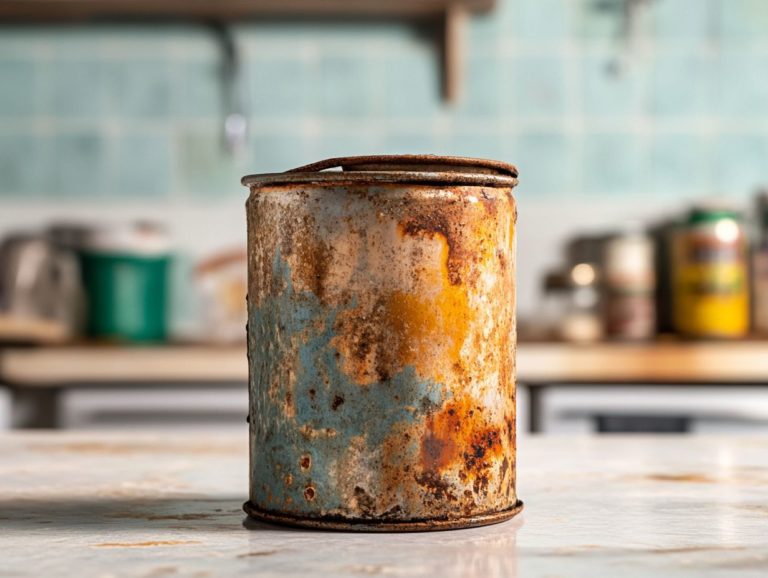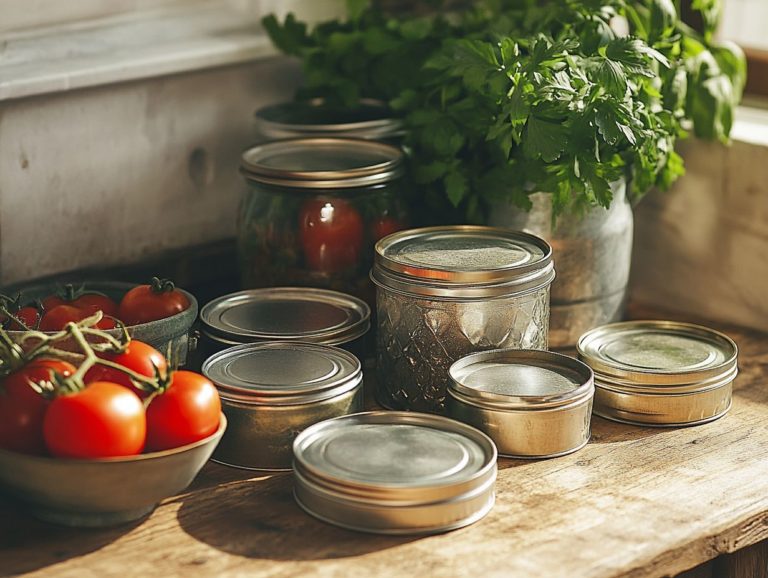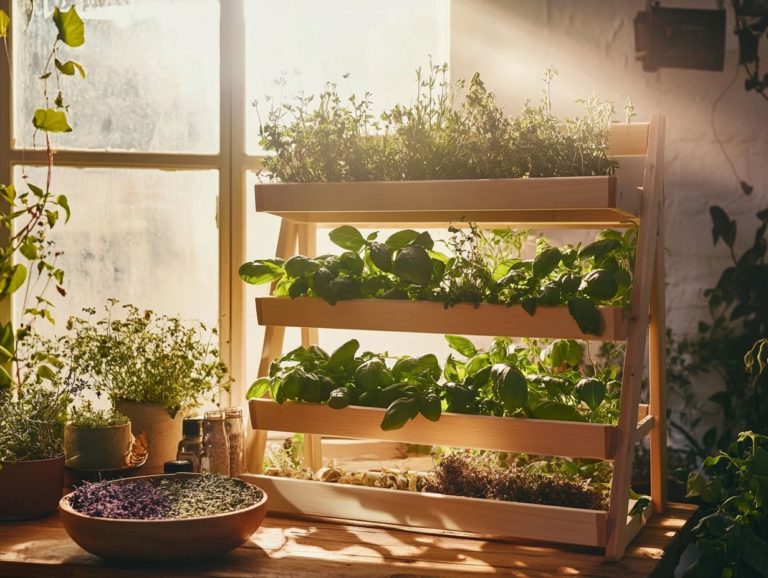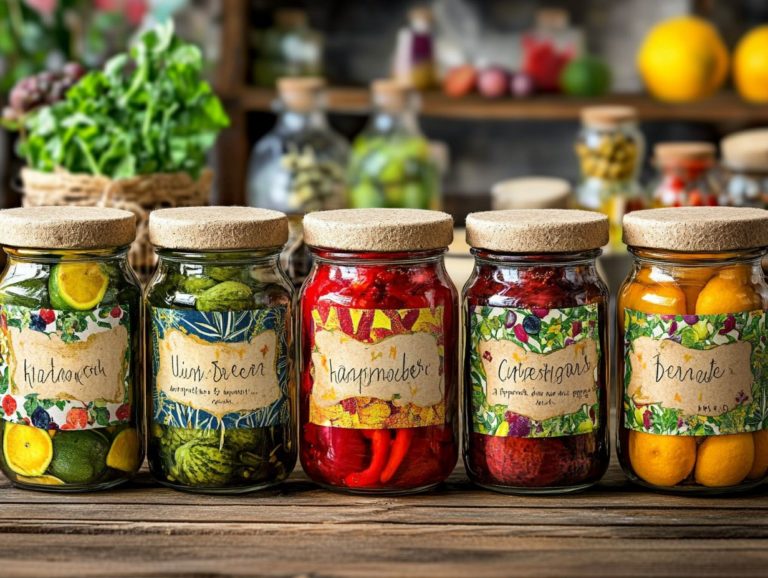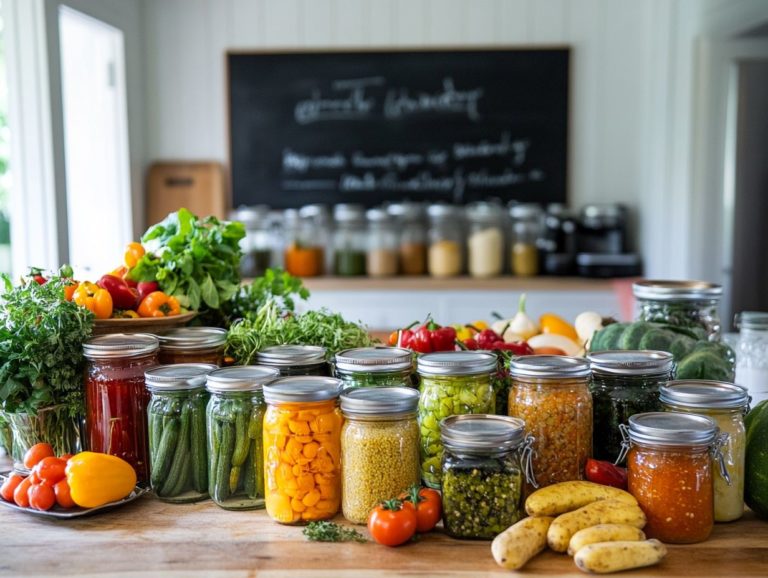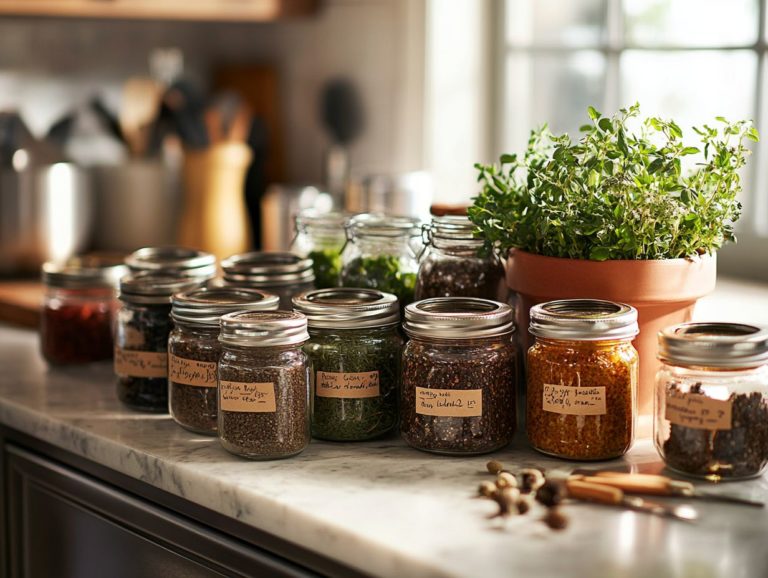How to Layer Ingredients for Effective Canning
Layering ingredients correctly is an essential aspect of canning 101 that significantly influences both flavor and shelf life.
This guide walks you through the fundamentals of layering, from the preparation and packing of ingredients to honing specific techniques tailored to various foods, such as refrigerator pickles and freezer jams. It highlights the many advantages of proper layering and provides valuable tips to ensure your canning endeavors result in delicious outcomes.
Get ready to boost your canning skills, whether you’re learning canning methods or perfecting preserving fruits for your next beef stew recipe.
Contents
- Key Takeaways:
- Why Layering is Important
- Step-by-Step Guide to Layering Ingredients
- Benefits of Proper Layering in Canning
- Common Mistakes to Avoid
- Tips for Successful Layering
- Frequently Asked Questions
- What is canning and why should I layer ingredients?
- How should I layer ingredients in canning?
- Can I mix different types of ingredients in one layer for canning?
- Do I need to leave space between layers when canning?
- Can I use any type of jar for canning?
- How many layers of ingredients can I have in one canning jar?
Key Takeaways:
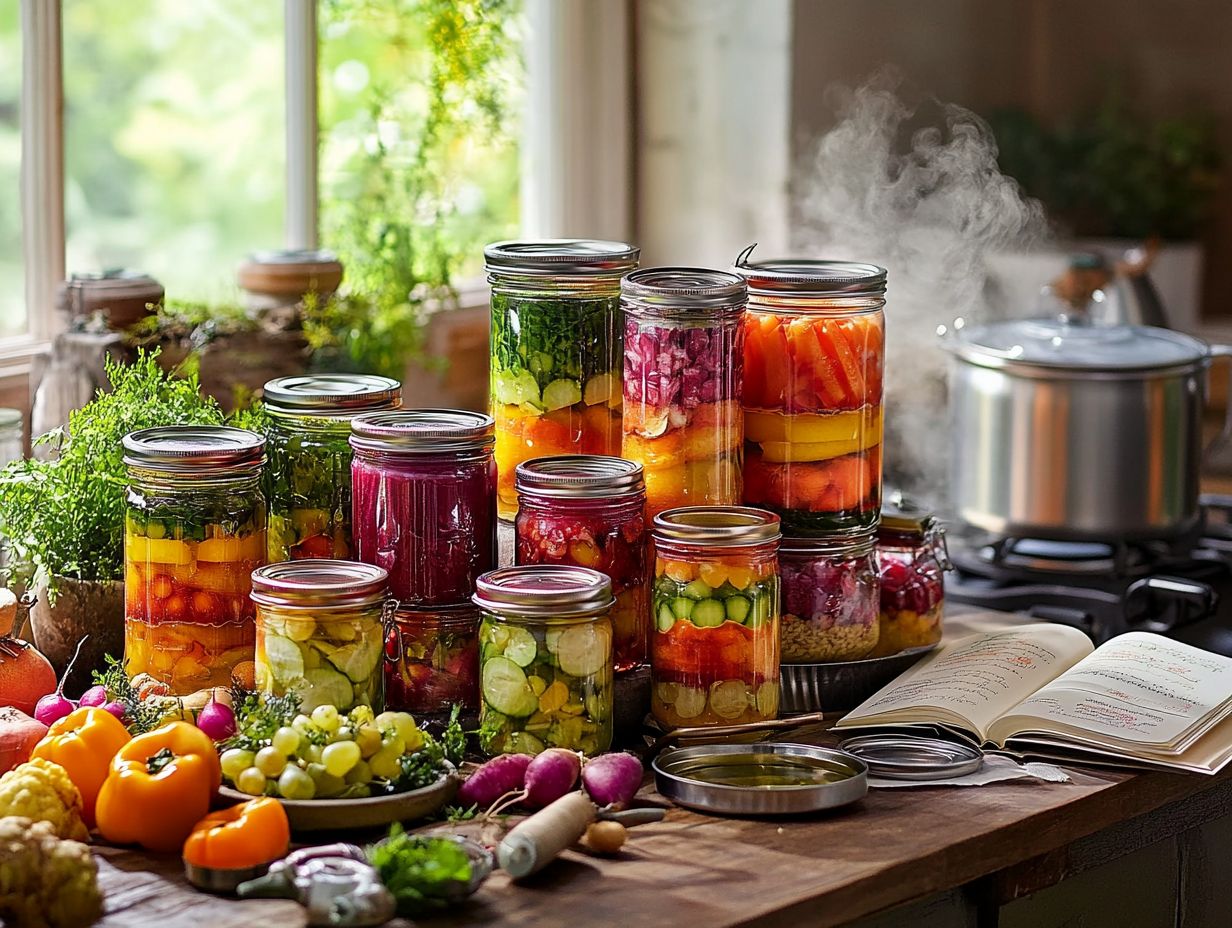
- Ensure proper layering for flavor and shelf life. Use a step-by-step guide tailored to different foods for success.
- Avoid common mistakes, such as improper layering, to prevent spoilage. Seek expert advice to improve your canning skills.
Why Layering is Important
Layering is an essential technique in food preservation. It elevates the quality and longevity of your canned goods while preventing issues like botulism, a serious foodborne illness that can occur without proper canning. This method ensures that flavors meld harmoniously while minimizing risks, especially when canning high-acid foods those that naturally contain acid, helping to prevent harmful bacteria.
Proper layering enhances the visual appeal of your creations and is vital for the overall safety and effectiveness of various canning methods. To ensure you’re prepared, consider the top 10 ingredients to stock for home canning.
Step-by-Step Guide to Layering Ingredients
This step-by-step guide will lead you through essential techniques to ensure your homemade gifts captivate the eye and preserve food safely. You ll maximize flavor and texture in every jar, creating delightful preserves that truly shine.
Preparing and Packing Ingredients
Preparing and packing your ingredients with care is crucial in canning. When you choose fresh, high-quality produce and place it in sterilized jars, you’re setting the stage for successful food preservation. This opens the door to creating everything from rich, homemade bone broths to vibrant canned beef and canned chicken.
The ingredients you select influence the flavor and play a significant role in the safety and longevity of your canned goods. By using equipment designed for canning and ensuring your jars are properly sterilized, you reduce the risk of spoilage and contamination.
For example, vacuum-sealing vegetables like green beans or pickling cucumbers locks in freshness and preserves that delightful crunch. If you treat fruits like peaches or strawberries with the right preparation, they can transform into luscious jams or sauces. Prioritizing immediately harvested and seasonal produce elevates the overall quality, ensuring your final product is both delicious and nutritious.
Start your canning journey today and enjoy delicious homemade preserves all year round!
Layering Techniques for Different Foods
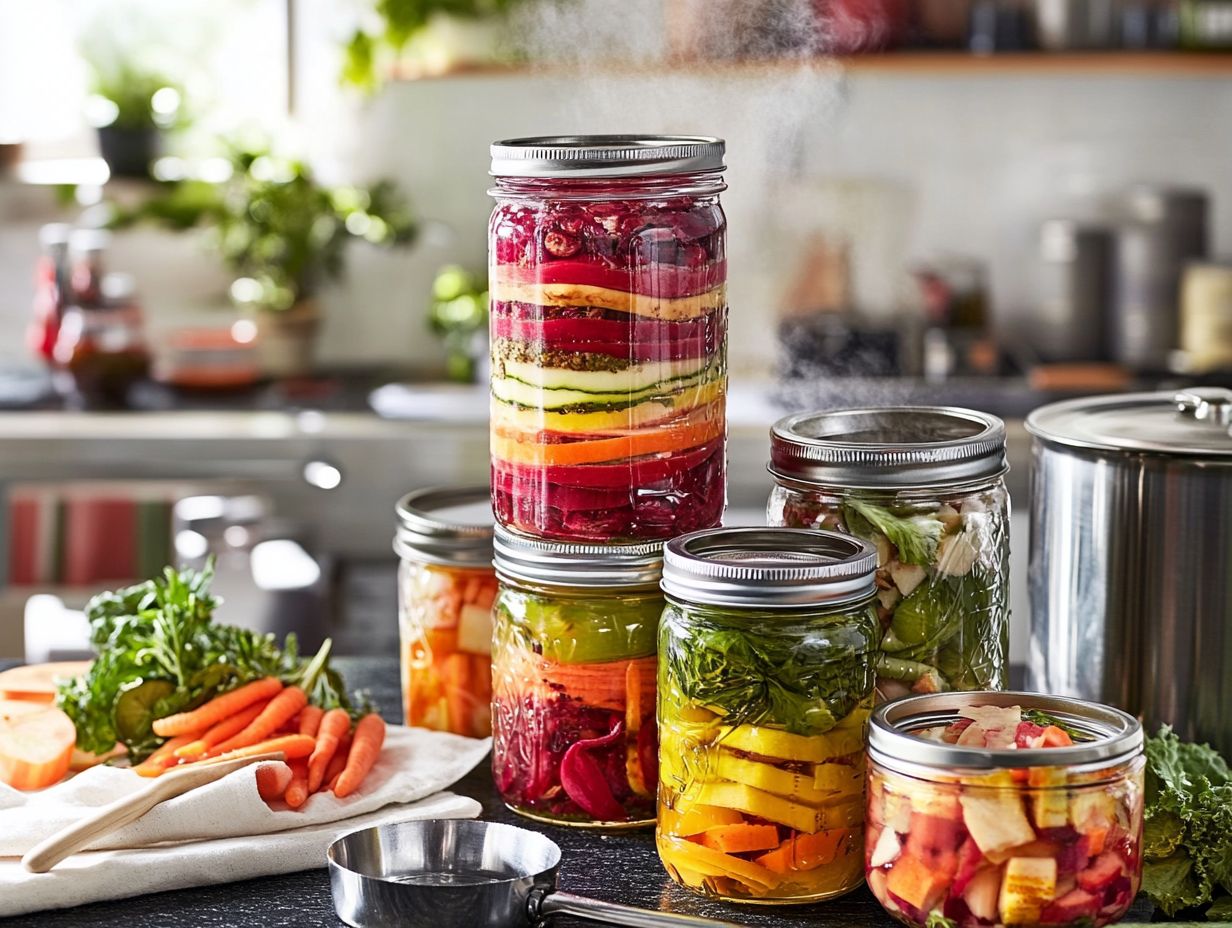
Unlock the secrets of canning with clever layering techniques! Your pantry will never be the same!
Different foods demand distinct layering techniques in the art of canning. Whether you re preserving high-acid foods like tomatoes with the boiling water bath method or tackling low-acid foods such as vegetables through pressure canning a method that uses high pressure to preserve low-acid foods, ensuring they remain safe to eat ensuring safety and flavor retention is paramount.
When canning high-acid foods, you ll find that carefully layering them in jars enhances heat distribution. This ensures even cooking and effective preservation. It s crucial for avoiding foodborne illness. A classic approach involves adding vinegar or citric acid to boost acidity, a crucial step for canning safety.
On the other hand, low-acid foods thrive under pressure canning, ensuring safe and effective preservation. Here, layering dense vegetables like carrots or beans becomes essential, as it guarantees that heat penetrates thoroughly, preserving their texture and vibrant flavors.
Grasping these nuances can significantly influence the effectiveness of your canning process and elevate the quality of the final product, transforming simple ingredients into cherished pantry staples.
Benefits of Proper Layering in Canning
Mastering the art of proper layering in canning opens the door to a multitude of benefits, such as an extended shelf life and an enhanced flavor profile in your cherished recipes, like canned jams. This careful method ensures that each spoonful remains fresh and delightful, transforming your canned jams into shelf-stable marvels.
Longer Shelf Life and Improved Flavor
By employing effective layering techniques, you can significantly extend the shelf life and enhance the flavor of your canned goods. This transforms ordinary ingredients into shelf-stable marvels that retain their freshness, even after long periods of storage.
Layering is crucial not just for preserving flavor integrity but also for maintaining the freshness of your ingredients, whether you’re using stainless steel utensils or a canning funnel. Techniques like vacuum sealing or using the right canning jars help prevent air exposure, which is a primary cause of spoilage.
Imagine layering roasted vegetables or marinated fruits within a jar; this creates distinct flavor profiles that deepen and evolve over time. When you thoughtfully arrange items like placing herbs above a sauce during home canning you create an infusion effect that elevates the taste, making every bite more delicious and complex.
As a result, your homemade spaghetti sauces or deli-style pickles will exhibit remarkable improvements in both longevity and taste, all thanks to your mindful layering approach.
Common Mistakes to Avoid
Avoiding common canning mistakes is crucial for ensuring both food safety and quality. When layering isn t done properly, you risk not only diminishing the flavor but also inviting spoilage or, even worse, serious foodborne illnesses like botulism.
Following canning safety rules is crucial for a successful and safe experience.
Problems with Improper Layering
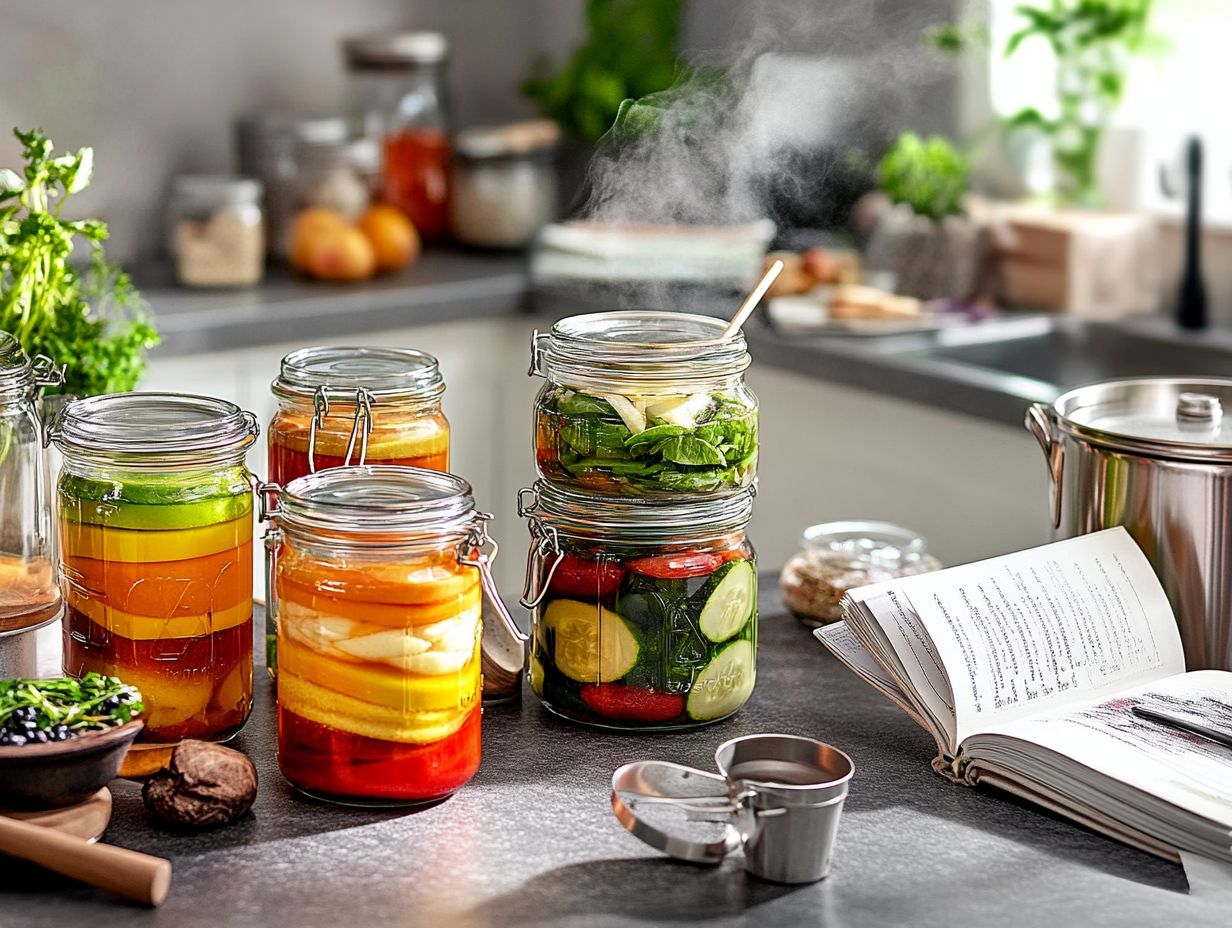
Improper layering when canning can lead to serious issues, including food spoilage and the risk of botulism. That s why it s essential to adhere to canning safety rules and best practices to ensure your preserved foods are both safe and delicious.
When you don t layer ingredients correctly, you might create pockets that fail to receive adequate heat during the canning process, significantly raising the risk of bacterial growth, especially from C. botulinum. This is particularly concerning with low-acid foods, which are more vulnerable to botulism.
To mitigate these risks, it s crucial to follow established guidelines regarding acidity levels, processing times, and jar sanitization. Always take a moment to check for signs of spoilage after canning, such as bulging lids or unusual odors, to help maintain safety.
By employing careful layering techniques and respecting these safety protocols, including proper jar sanitization, you can truly enjoy the fruits of your labor without compromising your health.
Tips for Successful Layering
To achieve successful layering in canning, follow expert advice and tips on how to prepare jars for canning that enhance both the efficiency of your canning process and the flavor retention in every jar. This ensures you can stock your pantry effectively.
This careful approach guarantees delicious homemade gifts that will wow your loved ones!
Expert Advice and Tricks
Expert advice on layering techniques can elevate your canning experience. This guidance, including how to use spices in canning techniques, helps you maximize the potential of your canning equipment and create beautifully layered jars of preserved foods.
Consider including three homemade meals that will undoubtedly impress your family and friends.
Thoughtfully select ingredients based on their texture, color, and flavor to enhance your culinary presentations. Start with denser items like beans or pickles at the bottom, followed by lighter elements such as tomatoes or herbs. This method creates a visually stunning effect and ensures optimal preservation.
Using tools like a canning funnel or bubble popper will help you achieve perfect layers while minimizing air pockets. This is crucial for creating foods that can be stored without refrigeration. These expert insights enhance both the taste and the appearance of your preserved goods, inviting everyone to indulge in your delightful homemade creations.
Frequently Asked Questions
What is canning and why should I layer ingredients?
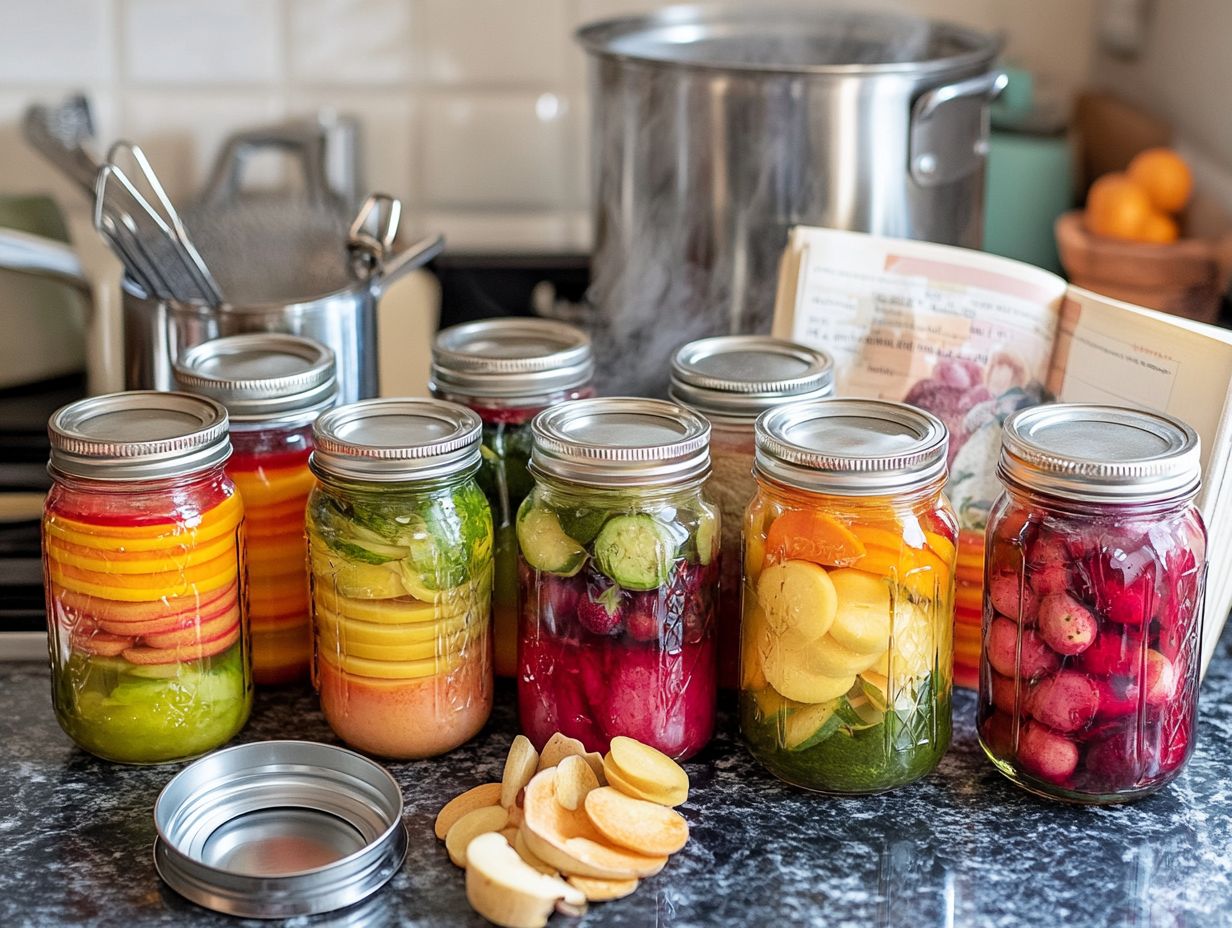
Canning is a method of preserving food by sealing it in airtight containers. Layering ingredients allows for more efficient preservation by promoting even heating and better distribution of flavors.
How should I layer ingredients in canning?
The general rule is to start with the densest ingredients at the bottom, such as root vegetables, and build up to the least dense, like leafy greens or delicate fruits.
Can I mix different types of ingredients in one layer for canning?
Yes, you can mix different types of ingredients in one layer as long as they have similar cooking times and densities. This ensures even cooking and preservation.
Do I need to leave space between layers when canning?
Yes, it’s important to leave about 1 inch of space between layers to allow for expansion during the canning process. This prevents jars from breaking due to pressure build-up.
Can I use any type of jar for canning?
No, use jars specifically designed for canning as they can withstand high temperatures and pressure. Using improper jars can lead to breakage and food spoilage.
How many layers of ingredients can I have in one canning jar?
The number of layers varies depending on the jar size and ingredients. It’s recommended to have at least 2-3 layers for effective canning, but not more than 6 layers to ensure proper heat distribution and preservation.

